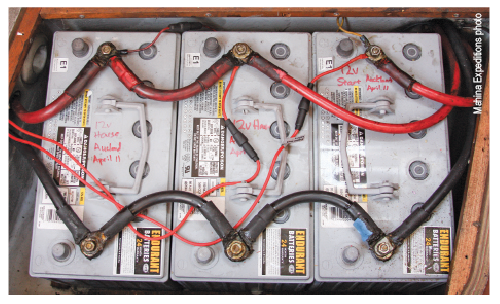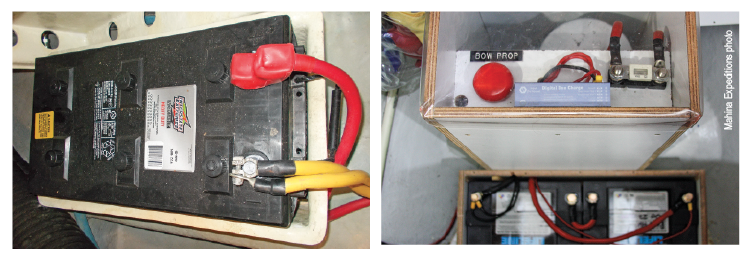Installing a new battery system
Upgrading your boat’s power grid is a good investment in time, money
Some upgrades and repairs on a sailboat are no-brainers. It’s not difficult know when you need new sails or the paint job and brightwork need attention. But figuring out if a battery upgrade is necessary and how to do it is at times less obvious. Odds are, though, that if the house batteries are more than five years old, you are going to want to think about replacing them. Wet-cell lead acid batteries have a life span of about five years. Some can be coaxed to perform longer, but their performance will degrade over time. If you’ve found that you are constantly charging the batteries or can’t run many of the systems you’d like to for long periods, it may be worth considering a battery upgrade as well.
Calculating load
The first place that any battery replacement or upgrade project should start with is a load calculation so you can analyze how much power you really need. Bigger is often better, but there’s no reason to spend on a battery system beyond what you need. And more importantly, it makes even less sense to go through the trouble and expense of replacing batteries with new ones that aren’t sufficient to handle the energy load.

The math doesn’t stop there, however. Next you need to refine your load calculations, and add up the amp hours for everything you’d like to be able to run for about 24 hours or the amount of time you’d like to go without charging the batteries, such as if you spend a night at anchor. If you want to run the refrigerator all night, multiply the amp usage by the number of hours it will run to get the total amp hours. Add up all of the amp hours for things like cabin lights, a television and anything else. The total of these amp hours should be less than 50% of the total battery capacity, and it’s better if it falls more in the 30% range. For instance, if the total amp-hour draw for a night at anchor is 150 amp hours, the battery bank should have a capacity of more than 300 amps, with 450 to 600 amps being ideal.
With the total load calculated, you can select batteries with the proper capacity. It’s a good time to plan for future upgrades you might be considering if they will also draw power, and it’s always a safe bet to add extra battery capacity to account for this and for the inevitable voltage drop that all systems experience. You also need to consider the boat’s alternator in this equation.
When you’re looking at flooded lead-acid batteries, the alternator amps should be a maximum of 25% of battery-system’s amp-hour rating capacity, which is printed on the battery. For example, if the alternator produces 100 amps, the maximum amp-hour rating of the batteries is 400.
Choosing batteries
Batteries have come a long way in a short time and boat owners now have several options. As with most choices, it’s a compromise between efficiency, cost and function, but most owners will be looking a lead-acid batteries. They have their limitations, of course. Flooded lead-acid batteries don’t do well with deep discharging and it’s challenging to get them to recharge fully (or even better than 60% of full charge).
Absorbed glass mat batteries offer much better efficiency, accept charge more readily, have better shock and vibration protection and produce less heat. For these reasons, AGMs have become the preferred choice for many boat owners. Another category—lithium ion batteries—is developing but these batteries have a significantly higher initial cost and are more complicated to install a system around.
With all of the load calculations and battery selection complete, the next step is to analyze the rest of your boat’s power grid. New cables will be required if you’re upgrading the battery bank, but it may be a good idea to consider new cables regardless. Heat is the enemy of cables and they can heat up quickly. Larger cables will be able to handle loads better than smaller cables, but care should be taken to choose cables that have a current-carrying capacity larger than required. Larger cables will also have less voltage drop than their smaller counterparts. When in doubt, get the largest cables that are practical. These can be ordered from marine supply stores, a battery specialist such as Balmar or through most boatyards.
Before you order anything though, make a schematic drawing of the boat’s power grid, including the battery bank, battery charger, alternator, battery switch and electrical panel. This will help make sure the system is well laid out and will help with cable-length calculations.
Installation
Once you remove the old batteries, installation can begin. Batteries must be installed in a manner that will collect any spilled electrolyte solution. This can be a plastic battery case or a purpose-tray, but resist any urge to just put them in any old locker. They also need to be secured with straps or clamps so that they can’t move more than one inch in any direction. Wait to do the actual connections to the batteries until the end of the process.
Then go back to the other end of the system—the electrical panel—and work backwards. It may be easiest to replace the cables (if you’ve opted for that upgrade) in sections as you remove the old cables. From there, go to the battery switch. Some older boats may not be equipped with a battery switch. They are inexpensive and a worthwhile addition that is easy to add to the system.

Next, make the connections to the alternator. For the purposes of this article, we’re assuming that the existing alternator is functional and sufficient, but if a new alternator is required, consider using an external regulator, which will add efficiency to the charging system. It bears repeating that the cables connecting the alternator to the batteries need to be of adequate size.
From here, run the main cable back from the switch to a circuit breaker located within 7 inches of the battery bank. This is a step that should be taken with any power source, be it the alternator, batteries or shore power. This is another part of the system that might be missing on older boats but is important to add. Choose a circuit breaker that is rated with an Ampere Interrupting Capacity for the size of the battery bank. For example, if your battery bank is rated for 650 cold-cranking amps, you will need a breaker that has an AIC of 1500. The greater the battery bank amps, the larger the AIC breaker.
Then mount the battery charger. A multistage, programmable charger that allows you to input the battery type is simple to install. You have some leeway in where this is mounted, but it cannot be mounted directly above the battery bank because of the risk of corrosive fumes from the batteries.
Finally it is time to make the battery connections. Batteries may have a maximum of four connections: the main cable, the battery charger, plus two more for things you’ll want to power outside the panel or that require constant power so as to not lose settings. These are often a bilge pump wire and a radio wire, so presets are not lost.
Cables should be connected with regular nuts and lock washers; do not use nylock nuts or wing nuts. The ungrounded conductor—the positive feed—needs to have protection over the top of the terminal to prevent an accidental short. A rubber boot or plastic cover does the job, but if the battery bank is enclosed in a plastic battery case that fulfills this requirement as well.

Upgrading your DC electrical system can be a DIY project that saves considerable cost over having a boatyard do the work. However, care must be taken in the installation to reduce the risk of an electrical fire, which is one of the main causes of fires onboard. It’s recommended that you consult with an ABYC technician or boatyard during any battery system upgrade.
With the final connections made, the system is up and running. Feel free to run that refrigerator a little longer.

Comments